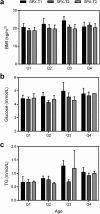Circulating Spexin Levels Negatively Correlate With Age, BMI, Fasting Glucose, and Triglycerides in Healthy Adult Women
- PMID: 29687092
- PMCID: PMC5905385
- DOI: 10.1210/js.2018-00020
Circulating Spexin Levels Negatively Correlate With Age, BMI, Fasting Glucose, and Triglycerides in Healthy Adult Women
Abstract
Context: Spexin is a newly identified neuropeptide that is involved in satiety control, glucose, and lipids metabolism. It has also been related to human diseases, such as obesity and type 2 diabetes. However, whether spexin changes with age or not is still unclear.
Objective: The aim of this study is to investigate the relationship between circulating spexin levels and age and to study their interaction effects on body mass index (BMI), fasting glucose, and -lipids.
Design and participants: This is a cross-sectional study, including 68 healthy adult women whose ages are in a wide range (minimum: 23; median: 38.5; maximum: 64).
Outcome measures: The serum spexin levels were measured by an enzyme-linked immunosorbent assay. Fasting glucose, total cholesterol, triglycerides (TG), alkaline phosphatase, alanine aminotransferase, aspartate aminotransferase, urea, and creatinine were measured by routine biochemical test. Shapiro-Wilk's test, Spearman and Pearson correlation analyses, χ2 test, and two-way analysis of variance were used to interpret the data.
Results: Serum spexin levels are significantly correlated with age (Spearman r = -0.277, P = 0.022), BMI (Spearman r = -0.445, P < 0.001), fasting glucose (Spearman r = -0.302, P = 0.014), and TG (Spearman r = -0.324, P = 0.008). Spexin levels independently predict the risk of high BMI and high fasting glucose. No interaction effects of spexin and age on BMI and fasting glucose were found.
Conclusions: Circulating spexin levels decrease with age, suggesting a possible role of this peptide in aging-related functions and disorders. Further investigations are needed to expand the clinical significance of this finding.
Keywords: age; body mass index; fasting glucose; healthy adult women; spexin; triglycerides.
Figures


Similar articles
-
Decreased Spexin Levels in Patients with Type 1 and Type 2 Diabetes.Med Princ Pract. 2018;27(6):549-554. doi: 10.1159/000493482. Epub 2018 Sep 5. Med Princ Pract. 2018. PMID: 30184546 Free PMC article.
-
Decreased Circulating Levels of Spexin in Obese Children.J Clin Endocrinol Metab. 2016 Jul;101(7):2931-6. doi: 10.1210/jc.2016-1177. Epub 2016 May 24. J Clin Endocrinol Metab. 2016. PMID: 27218269 Free PMC article.
-
Spexin peptide is expressed in human endocrine and epithelial tissues and reduced after glucose load in type 2 diabetes.Peptides. 2015 Sep;71:232-9. doi: 10.1016/j.peptides.2015.07.018. Epub 2015 Jul 23. Peptides. 2015. PMID: 26211893 Clinical Trial.
-
Roux-en-Y gastric bypass surgery in youth with severe obesity: 1-year longitudinal changes in spexin.Surg Obes Relat Dis. 2018 Oct;14(10):1537-1543. doi: 10.1016/j.soard.2018.07.007. Epub 2018 Jul 20. Surg Obes Relat Dis. 2018. PMID: 30131311
-
Spexin status in relation to obesity and its related comorbidities: a systematic review.J Diabetes Metab Disord. 2020 Nov 7;19(2):1943-1957. doi: 10.1007/s40200-020-00636-8. eCollection 2020 Dec. J Diabetes Metab Disord. 2020. PMID: 33520870 Free PMC article. Review.
Cited by
-
Low levels of spexin and adiponectin may predict insulin resistance in patients with non-alcoholic fatty liver.Pract Lab Med. 2021 Feb 7;24:e00207. doi: 10.1016/j.plabm.2021.e00207. eCollection 2021 Mar. Pract Lab Med. 2021. PMID: 33665291 Free PMC article.
-
Circulating Spexin Is Associated with Body Mass Index and Fat Mass but Not with Physical Activity and Psychological Parameters in Women across a Broad Body Weight Spectrum.J Clin Med. 2022 Aug 30;11(17):5107. doi: 10.3390/jcm11175107. J Clin Med. 2022. PMID: 36079049 Free PMC article.
-
Normalization of Spexin Levels in Patients with Obesity Submitted to Bariatric Surgery.Obes Surg. 2024 Feb;34(2):449-455. doi: 10.1007/s11695-023-06972-x. Epub 2023 Dec 11. Obes Surg. 2024. PMID: 38072893
-
Evolution of Structural and Functional Diversity of Spexin in Mammalian and Non-mammalian Vertebrate Species.Front Endocrinol (Lausanne). 2019 Jun 19;10:379. doi: 10.3389/fendo.2019.00379. eCollection 2019. Front Endocrinol (Lausanne). 2019. PMID: 31275244 Free PMC article. Review.
-
Spexin as an indicator of beneficial effects of exercise in human obesity and diabetes.Sci Rep. 2020 Jun 30;10(1):10635. doi: 10.1038/s41598-020-67624-z. Sci Rep. 2020. PMID: 32606431 Free PMC article.
References
-
- Kim DK, Yun S, Son GH, Hwang JI, Park CR, Kim JI, Kim K, Vaudry H, Seong JY. Coevolution of the spexin/galanin/kisspeptin family: spexin activates galanin receptor type II and III. Endocrinology. 2014;155(5):1864–1873. - PubMed
-
- Rucinski M, Porzionato A, Ziolkowska A, Szyszka M, Macchi V, De Caro R, Malendowicz LK. Expression of the spexin gene in the rat adrenal gland and evidences suggesting that spexin inhibits adrenocortical cell proliferation. Peptides. 2010;31(4):676–682. - PubMed
LinkOut - more resources
Full Text Sources
Other Literature Sources
Miscellaneous
